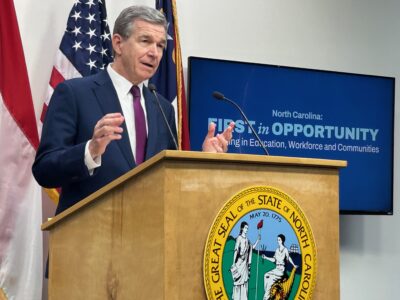
$32.9 billion vs. $29.7 billion in 2023-24. $34.2 billion vs. $30.8 billion in 2024-25.
These big numbers encapsulate big decisions just ahead in North Carolina. Crafting a state budget can come across as abstract and esoteric — a billion here, a billion there — but of course the process is especially consequential for education in this state in which 60% of the General Fund goes to operate public schools, community colleges, and universities.
The 3-to-4-billion-dollar difference in the key pairs of figures define the chasm between Democratic Gov. Roy Cooper’s proposed General Fund appropriations and the much lower spending targets announced by the Republican leaders of the General Assembly. Bridging that chasm appears especially difficult in a divided government not only of heated partisanship but also with divergent approaches to governance.
The GOP budget targets, given to appropriations committees to guide their work, would permit increases of 6.5% and 3.75% in state spending over the next two fiscal years. But the targets are set well below anticipated revenues of $33.71 billion in 2023-24 and $33.65 billion in 2024-25.
Since winning a legislative majority in 2010 and solidifying it over a decade, Republican lawmakers have adhered to limited government practices of lean budgets and lower taxes. In a pre-session panel discussion convened by Business North Carolina, state Rep. Jason Saine, one of the three “senior chairs” of the House Appropriations Committee, gave voice to the GOP approach in personal terms: “I’m an appropriator who doesn’t like to spend money.”
As a prevailing narrative reminds voters, Republican lawmakers are merely one vote short of a veto-proof majority. Less attention has been given to how much the Democratic governor’s budget plan, even though unlikely to be adopted, stands as a challenge to core principles of Republican fiscal policies.
Cooper’s recommendations challenge the case for an austere budget at a moment of better-than-anticipated revenue growth and of need for education investments to provide young North Carolinians with knowledge and skills to obtain family-sustaining jobs. The governor also challenges the prudence of prolonging tax cuts that shift the overall burden from corporations and the affluent to middle- and lower-income individuals.
In 2013, the Republican legislative majority reconfigured the state tax system — and then pursued further reductions over the past decade. The state now has a “flat” individual income tax with a single rate instead of graduated rates based on ability to pay. North Carolina has the lowest corporate income tax rate of states with such a tax — and lawmakers intend to phase it out completely. The 2013 package also picked up revenue by extending the full sales tax rate to such items as movie tickets, modular homes, and utilities.
The Cooper budget proposal would not roll back the tax-cutting spree initiated 10 years ago. But the governor calls for modest shifts to forestall further erosion of the state’s revenue base. He would retain the current corporate tax rate at the minimal 2.5% rate rather than eliminating the tax. He would also keep the transfer of sales tax revenue to the highway fund at 2% rather than 6% in future years.
Significantly, the governor recommends restoring a modest measure of graduation on ability-to-pay to the individual income tax. Married couples filing jointly with income above $200,000 would remain at the current 4.75% rate, while people below that level would be taxed at the lower 4.5% rate set for 2025, under the Cooper plan.
Once the state had rebounded from the Great Recession of 2008-09, North Carolina clearly went on a robust roll of population growth and economic expansion. The question remains: Can that roll be attributed as largely to tax cuts and tight budgets as advocates argue?
After all, North Carolina ranked among the top states for business in the 2000-10 decade. And as documented by the Federal Reserve and Statista, North Carolina had a steadily rising gross domestic product from 2000 to 2020, with brief downturns during the recession and the pandemic, both inflictions of national and global origin.
In other words, North Carolina had been on the move before the austere budgets and tax reduction spree of the past decade. And now the chasm between the governor’s higher recommendations and the legislative majority’s lower targets point again to fundamental differences in priorities and values. Doesn’t North Carolina, indeed, have the economic and civic strength to propel its schools, colleges, and universities to advance the lifetime prospects of its rising generation?



